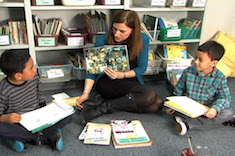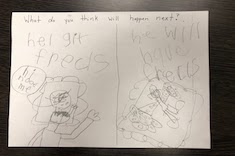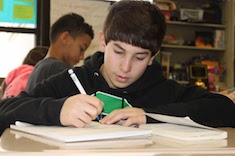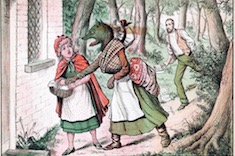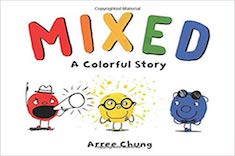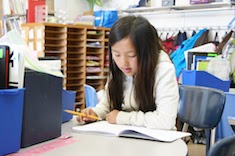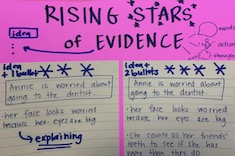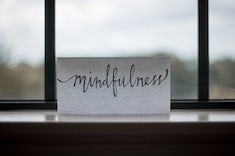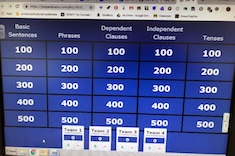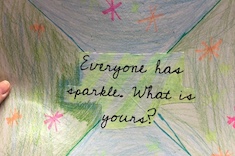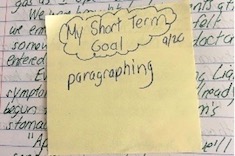Articles
Here is where you’ll find all the latest print features from our contributors. If you’d like to browse specifically by grade level, topic, or contributor, you can use the links in the right sidebar.
Latest Content
Getting Started with Strategy Lessons
Tara Barnett and Kate Mills describe how they help teachers move from guided reading to strategy groups in the upper elementary grades.
Slowing Down
Bitsy Parks comforts a crying child after lunch, and realizes how essential it is to continually slow down the fast pace of learning in her classroom.
Don’t Forget to Marvel
Ruth Ayres is interrupted during a busy day by a first-grade teacher who enthuses over the details in a student draft. This leads to some reflection on the importance of taking time to marvel.
Think Small
Christy Rush-Levine realized she had to help her students find a different “why” for their time in her classroom and school beyond test scores and standards dictates.
Secret Reader
Suzy Kaback marvels at a very young learner who is a “secret reader,” and this leads her to reassess the value of constantly celebrating new skills in school communities.
Poetry Path
Gretchen Schroeder outlines a way to involve the entire school community in engaging in poetry.
Google It!
Ruth Ayres encourages her son to use the web for assistance when doing homework, and then has to ponder whether what she is advocating qualifies as cheating.
Unadulterated Reading
Just reading. Pure, unadulterated reading. That’s the reading homework that matters most in the long run. Stephanie Affinito explains why.
Conferences with Parents of English Language Learners
Jen Schwanke and Stella Villalba share practical tips for conferring with parents of English language learners.
A Fresh Take on Persuasive Writing
Louise Wrobleski uses video clips, children’s literature, and newspaper articles to teach middle school students new ways to craft persuasive writing.
Reading That Changes Us
Tara Barnett and Kate Mills slow down the “Article of the Week” nonfiction reading activity, making space for more reflection and thoughtful discussion.
Building Cultural Awareness
Stella Villalba explains how frustrations with the families of English language learners can come from misunderstandings of cultural norms, and gives some tips for building awareness.
Reading Bingo
Gretchen Schroeder has developed a fun version of Reading Bingo to help students explore their identity as readers. The activity includes clever social media inspired options like creating memes and “bookstagram” posts.
The Power of Paper
Melanie Meehan details how different paper options can be a powerful scaffold for students as they explore different writing genres. She includes many sample scaffolds to download for use in an opinion writing unit.
Scaffolding Revision with a Mentor Text
Tara Barnett and Kate Mills show how to break down mentor texts into brief excerpts for step-by-step scaffolding of writers in the intermediate grades.
Bringing Multiple Texts and Perspectives into Teaching Point of View
Katherine Sokolowski finds her students are struggling to understand point of view. She takes a detour over a week with mentor texts, quick assists from favorite writers on Twitter, and practice sessions retelling Little Red Riding Hood to teach the concept.
Detour Texts
Clare Landrigan and Tammy Mulligan explain the concept of “detour texts”—picture books to use as mentor texts in the intermediate grades to illustrate complex literary elements. They also share three of their favorite new children’s books to use as detours.
Revising Dialogue in Narrative Writing
Melanie Meehan finds that a “lift the flap” strategy works for showing students different revision options with dialogue.
Practical Revision Strategies
If your students are equating revision with proofreading and final cleanups, Tara Barnett and Kate Mills have some practical revision strategies you might want to try.
Linking Evidence to Reading Response in First Grade
Tara Barnett and Kate Mills are discouraged by the random and idiosyncratic responses to reading they are seeing among first graders. They implement a series of lessons to help students move to evidence-based reading responses.
Readers Want to Respond
Matt Renwick is surprised when his son completes a reading quiz that isn’t required, and finally realizes it’s all about reading response.
5 Strategies for Engaging Boy Writers
Jennifer Allen has been fascinated with helping boys write for years, ever since her own son insisted on writing on the same topic over and over again. She shares her five favorite strategies for boosting interest in writing among boys.
Things That Can Fly Away—A Tribute to Mary Oliver
Shirl McPhillips honors the poet Mary Oliver upon her passing, reflecting on the power of favorite poems and poets to endure in the lives of writers.
Mindful Test-Taking
High-stakes tests weigh on teachers and students through the winter and spring. Mark Levine shares mindfulness strategies for test-taking, explaining how to help students recommit and refocus in the midst of an exam.
Grammar Games
Melanie Meehan shares two of her favorite games for teaching grammar, including templates and web resources.
Picture Books to Teach Digital Citizenship
Students aren’t just collaborative in our classrooms—they are connecting with others all over the world. Stephanie Affinito shares her favorite picture books to teach digital citizenship.
An All-School Writing Project: Six-Word Memoirs
If you want to bring everyone in your school together around writing, you can’t beat the simplicity and fun of six-word memoirs. Jennifer Schwanke describes how she sparked enthusiasm for the project in her school.
The Importance of Correct Examples
Melanie Meehan explains why it is important to mentor students who are struggling with correct examples, and why she cautions writing teachers to avoid “find the mistakes” exercises.
The Magic That Might Go Down
Christy Rush-Levine decides to slow down in her classroom and engage more fully with a student who is a wiseacre and resistant reader. What happens next can only be described as magic.
Building Habits with Short-Term Goals
Tara Barnett and Kate Mills explain why short-term writing goals can help students reset expectations for their writing on a daily basis, and how they make these goals an integral part of their writing workshops.
Browse Content By
Type
Category
- Assessment Tools
- Big Fresh Archives
- Booklists
- Choice Numeracy
- Classroom Design
- Common Core
- Community Building
- Conferring
- Content Literacy
- Digital Literacy
- English Language Learners
- Equity
- Family Relations
- Free Samples
- Guiding Groups
- Leadership
- Literacy Coaches
- Mentor Texts
- Minilessons
- New Teacher Mentors
- Podcasts
- Poetry
- Quote Collections
- Reading Strategies
- Self Care
- Struggling and Striving Learners
- Talking and Listening
- Teacher Study Groups
- Teaching Reading
- Teaching Writing
- Word Study and Vocabulary
Author
- Melissa Quimby
- Nawal Qarooni
- Gwen Blumberg
- Julie Cox
- The Lead Learners
- Hannah Tills
- Josie Stewart
- Ruth Metcalfe
- Mallory Messenger
- Becca Burk
- Jodie Bailey
- Vivian Chen
- Mary Brower
- Tiffany Abbott Fuller
- Stephanie Affinito
- Ruth Ayres
- Leigh Anne Eck
- Heather Fisher
- Shari Frost
- Julie Johnson
- Suzy Kaback
- Gigi McAllister
- Shirl McPhillips
- Melanie Meehan
- Cathy Mere
- Debbie Miller
- Tara Barnett and Kate Mills
- Tammy Mulligan
- Dana Murphy
- Bitsy Parks
- David Pittman
- Brenda Power
- Heather Rader
- Matt Renwick
- Mandy Robek
- Christy Rush-Levine
- Gretchen Schroeder
- Jen Schwanke
- Brian Sepe
- Katherine Sokolowski
- Stella Villalba
- Jennifer Vincent
Grade Level
Choice Literacy Membership
Articles
Get full access to all Choice Literacy article content
Videos
Get full access to all Choice Literacy video content
Courses
Access Choice Literacy course curriculum and training

